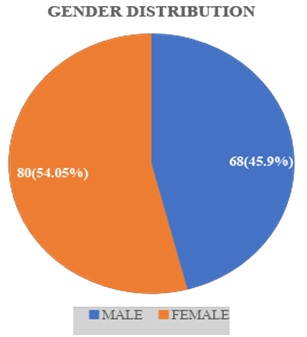Drug resistant microorganisms isolated from the cases of Otitis media in a tertiary care hospital
Abstract
Introduction: Otitis media (OM) is a major health problem worldwide. WHO has reported hearing impairment in 42 million people (above 3 years) globally was mainly caused by OM. The prevalence rate of ASOM in India is around 17-20% and CSOM is 7.8%.
Objective: The aim was to determine microbiological profile of organisms causing otitis media and to assess their antibiotic susceptibility pattern from our geographical area.
Methods: This is a prospective study of 148 clinically suspected cases of OM (ASOM & CSOM). Samples were cultured and antibiotic susceptibility test was performed as per CLSI guidelines.
Result: Out of 148 cases of OM, the male to female ratio was 1:1.17,97(65.54%) were culture positive and 51(34.45%) culture negative. Among bacterial pathogens, Staphylococcus aureus was the commonest organism isolated (31.57%) followed by Pseudomonas aeruginosa (20%). Of the staphylococcus aureus isolates, 14(46.66%) were MRSA. Majority of Staphylococcus aureus isolates were found resistant to multiple antibiotics including Penicillin G (96.6%) & Azithromycin (76.6%). High level of resistance observed in the isolates of Pseudomonas aeruginosa [Imipenem (31.57%) and Ceftazidime (52.63%)]. Multidrug resistance was also found in Enterobactericeae, showing resistance to Cotrimoxazole (76.19%) & Amoxicillin-clavulanic acid (66.66%). GNNF was found 100% sensitive to imipenem and 50% resistant to ciprofloxacin.
Conclusion: Emergence of resistance strains among the isolates of OM has led to treatment failure leaving narrow spectrum of treatment options. Therefore, knowledge of microorganism profile and their antibiotic sensitivity pattern is important for the management of the disease and to prescribe empirical antibiotics for successful treatment.
Downloads
References
2. Kumari MS, Madhavi J, Krishna NB, Meghanadh KR, Jyothy A. Prevalence and associated risk factors of otitis media and its subtypes in South Indian population. Egyptian Society of Ear, Nose, Throat and Allied Sciences 2016;17:57-62. Doi: http://dx.doi.org/10.1016/j.ejenta.2016.04.001
3. Lazo-Saens JG, Galvan-Aguilera AA, Martinaz-Ordaz VA, Velasco-Rodriguez VM, Nieves-Renteria A, Rincon-Castaneda C. Eustachian tube dysfunction in allergic rhinitis. OtolaryngolHeadNeck Surg. 2005;132:626-629. doi: https://doi.org/10.1016/j.otohns.2005.01.029
4. Shrestha BL, Amatya RCM, Shrestha I, Ghosh I. Microbiological profile of chronic suppurative otitis media. Nepalese Journal of ENT Head and Neck Surgery 2011;2(2)6-7.
5. Prakash M, Lakshmi K, Anuradha S, Swathi GN. Bacteriological profile and their antibiotic susceptibility pattern of cases of chronic suppurative otitis media. Asian J Pharm clin res. 2013;6(suppl 3):210-12.
6. Gopi A, Kottilaveetil HT, Khair SMU, Harindranath D. Bacteriological profile of chronic suppurative otitis media cases at a tertiary care centre in Karnataka. J Evolution Med Dent Sci. 2016;5(14):623-626. DOI: 10.14260/jemds/2016/142.
7. Afolabi OA, Salaudeen AG, Ologe FE, Nwabuisi C, Nwawolo CC. Pattern of bacterial isolates in the middle ear discharge of patients with chronic suppurative otitis media in a tertiary hospital in North central Nigeria. African Health Sciences 2012;12(3):362-368. DOI: http://dx.doi.org/10.4314/ahs.v12i3.18.[pubmed]
8. Bhumbla U, Paul S, Mathur DR, Gyaneshwari. Bacteriological Study of CSOM and their Changing Pattern of Antibiotic Sensitivity and Resistance. Int.J.Curr.Microbiol.App.Sci 2016;5(10):282-288. DOI: http://dx.doi.org/10.20546/ijcmas.2016.510.031.
9. Kumar R. Acute Otitis Media bacteriological study and drug sensitivity pattern. J Evolution Med Dent Sci 2013 Sep 23;2(38)7297-7301.
10. Garima, Chaurasia D, Poorey VK. Antimicrobial susceptibility pattern of bacterial isolates from chronic suppurative otitis media patients in Central India. Indian J Microbiol Res 2016;3(4):373-382. DOI: 10.18231/2394-5478 .2016.0006
11. Srivastava A, Singh RK, Varshney S, Gupata P, Bist SS, Bhagath S, et al. Microbiological evaluation of an active tubotympanic type of CSOM. Nepalese J ENT Head Neck Surg. 2010;1(2):14-16.
12. Agrawal A, Kumar D, Goyal A, Goyal S, Singh N, Khandelwal G. Microbiological profile and their antimicrobial sensitivity pattern in patients of otitis media with ear discharge. Indian J Otol2013;19:5-8.
13. Fatma AA, Assiry S, Siraj MZ. Microbiological evaluation and aspects on management of chronic suppurative otitis mediain Riyadh. Indian J Otol1998;4:115-20.
14. Prakash R, Juyal D, Negi V, Pal S, Adekhandi S, Sharma M, Sharma N. Microbiology of Chronic Suppurative Otitis Media in a Tertiary care setup of Uttarakhand state, India. N AM J Med Sci 2013 Apr;5(4):282-287. DOI: 10.4103/1947-2714.110436.[pubmed]
15. Nia KM, Sepehri G, Khatmi H, Shakibaie MR. Isolation and Antimicrobial Susceptibility of Bacteria from Chronic Suppurative Otitis Media Patients in Kerman, Iran. Iran Red Crescent Med J 2011 Dec; 13(12):891-894.
16. Kumar H, Seth S, Bacterial and Fungal study of 100 cases of Chronic Suppurative Otitis Media. JCDR 2011;5:1224-27.
17. Shyamla R, Reddy SP, the study of bacteriological agents of Chronic Suppurative Otitis Media-aerobic culture and evaluation. J Micro biol Biotechno Res 2012;2:152-62.
18. Mansoor T, Musani MA, Khalid G, Kamal M. Pseudomonas aeruginosa in Chronic Suppurative Otitis Media: Sensitivity spectrum against various antibiotics in Karachi. J Ayub Med Coll Abbottabad 2009;21:120-23.[pubmed]
19. Malkappa SK, Kondapaneni S, Surpam RB, Chakraverti TK. Study of aerobic bacterial isolates and their antibiotic susceptibility pattern in Chronic Suppurative Otitis Media. Indian J Otol2012;18:136-39.
20. Hegde MC, Bhat GK, Sreedharan S, Ninan GP. Bacteriological study of tubotympanic type of Chronic Suppurative Otitis Media. Indian J Otol2005;11:13-16.
21. Khatoon A, Rizvi M, Sultan A, Khan F, Sharma M, Shukla I et al. Chronic Suppurative Otitis Media: a clinic-microbiological menance. International J Res Med Sci 2015;3(8):1932-36.
22. Rejitha IM, Sucilathangam G, Kanagapriya M. Microbiologic profile of chronic suppurative otitis media in a tertiary care hospital. International J Sci Res 2014;3(2):474-76.
23. Nia KM, Sepehri G, Khatmi H, Shakibaie MR. Isolation and antimicrobial susceptibility of bacteria from chronic suppurative otitis media patients in Kerman, Iran. Iran Red Crescent Med J 2011;13:891-4.
24. Tahir M, Jawaid A, Abdullah A, Najam MA. Bacterial culture and sensitivity in active chronic otitis media: 500 cases in combined military hospital Rawalpindi. Pak J Otolaryngol2012;28:56-8. 16.
25. Madana J, Yolmo D, Kalaiarasi R, Gopalakrishnan S, Sujata S. Microbiological profile with antibiotic sensitivity pattern of cholesteatomatous chronic suppurative otitis media among children. Int J PediatrOtorhinolaryngol2011;75:1104-8.



 OAI - Open Archives Initiative
OAI - Open Archives Initiative


